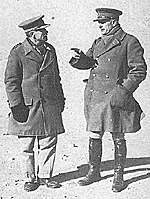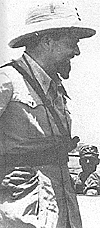 During the Second World War, the British army produced some excellent
generals. Although many were highly publicized for their exploits ,there
was one general in particular, who did not get the media attention he truely
deserved. This great general was Richard O'Connor. For his amazing
exploits he deserves a better and honourable remembrance.
During the Second World War, the British army produced some excellent
generals. Although many were highly publicized for their exploits ,there
was one general in particular, who did not get the media attention he truely
deserved. This great general was Richard O'Connor. For his amazing
exploits he deserves a better and honourable remembrance.
O'Connor (left) and Wavell. From The Crucible of War.
This takes us back to the sands of North Africa in the year 1940. The French had accepted the German terms on June 22nd, with the Compiegne Armistice, and this armistice became effective at 1:35 a.m. on June 25th. This left the Italians free to concentrate its troops for its planned invasion of Egypt as its tunisian frontier was now safe.
Major-General Richard O'Connor was given command of the Western Desert force, with the duty of protecting Egypt from an Italian attack. The commander-in-chief of all Middle East forces was General Archibald Wavell. Wavell had full confidence in O'Connor's unorthodox leadership qualities.
O'Connor unorthodoxy lay in his taking risky missions personally. For example, he used to make personal reconnaissance deep into enemy territory, and many times his troops reported seeing General O'Connor coming from the enemy's direction. This method, remarkably similar to the one used later by Rommel in the desert, was to become his personal trademark of daring, courage, and valour.
 The Italian command in Libya changed when Balbo (at right, From The Crucible of War) was shot down by his own
anti-aircraft batteries. He was replaced by Marshal Rodolpho Graziani, who
became the new Governor-General and commander-in-chief in Libya. Marshal
Graziani was a ruthless fascist who performed well in Abyssinia in 1936. On
7th September, Rome ordered Graziani to attack Egypt in two days. On 13th
september, the Italian Army moved.
The Italian command in Libya changed when Balbo (at right, From The Crucible of War) was shot down by his own
anti-aircraft batteries. He was replaced by Marshal Rodolpho Graziani, who
became the new Governor-General and commander-in-chief in Libya. Marshal
Graziani was a ruthless fascist who performed well in Abyssinia in 1936. On
7th September, Rome ordered Graziani to attack Egypt in two days. On 13th
september, the Italian Army moved.
The attack began with a heavy artillery bombardment on empty British frontier posts. after that the Italian Tenth Army, with its four divisions and groups of tanks, moved into Egypt. After a sixty mile advance into Egypt, Graziani stopped at Sidi Barrani to build a metalled road up from the frontier to secure his chain of supplies.
It seems he was in no hurry to attack the main British army at mersa Matruh which was still eighty miles from Sidi Barrani. Graziani made a series of fortified camps around Sidi Barrani.
More General Richard O'Connor: British Western Desert Force
Back to Table of Contents -- World War Two Newsletter
Back to World War Two Newsletter List of Issues
Back to MagWeb Magazine List
© Copyright 2001 by Shahram Khan.
This article appears in MagWeb (Magazine Web) on the Internet World Wide Web.
Other military history articles and gaming articles are available at http://www.magweb.com